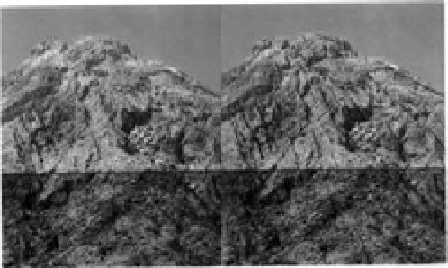Environmental Engineering Reference
In-Depth Information
Table 5.
non-dimensional Π numbers of volcanoes in general (15, 31, 48, 49) and the case of the arenal Volcano.
Dimensional ratios
Volcanoes (arenal)
comments
interpretation
Π
1
= h/R
0.15-0.55 (0.27)
The relation between Π
1
and Π
3
controls the dynamic evolution of
the volcano. Π
1 t
ends to decrease
with time, however its increase
becomes a factor of instability
its intermediate value suggests
some cone instability. since the
volcano is still growing, its insta-
bility increases with a constant
radio.
Π
2
= D/h
0-1.5 (0.09-0.18)
For a given thickness, it provides
the critical height where the weight
impulses the deformation: < 0.4.
si Π
2
> 0.4, the cone is stable
since Π
2
<0.4, there is some
dispersion or cone instability
0-20 (0.8-10) (4.3)
Determines the type of deformation
and grabens number. if < 4, the
collapse begins. if Π
3
≅ 10, no
spreading is presented even if Π
2
<0,4. if Π
3
is between 0,1 and 1, the
number of grabens should be 4 and
if it is 3, there would be 6 or 7
grabens.
since the arenal cone is young, the
number of grabens are not still
develop and the spreading on its
base is incipient.
Π
3
= D/i
1-1.5 (1.05)
helps estimate the volcanos weight
on the substrate. The increase of Π
4
(from 1 to 1,5) has the same effect
than the decrease of Π
3.
There could be some spreading at
its base as a fold belt.
Π
4
= ρv/ρs
Π
5
= ρv ⋅g h ⋅t/µ
0.01-790 (0.66)
since volcanoes tend to grow, an
increase of Π
5
transforms the cone
from a stable type to spreading type
The arenal volcano is in an incipi-
ent spreading stage.
Πa = R/i
0.3-50 (32-200)
if the ductile layer is too thin (Πa >1),
spreading occurs, while if it is
too thick (Πa < 1), flexion occurs
since the weak layer is very thin
compare to the volcano (Π
a
> 1),
spreading occurs
* Π
b
= µ ⋅ i / c ⋅D ⋅t 166-1 000 000
(45.4-568) (247.1)
The most common way to evaluate a talus sta-
bility, is through the determination of a factor
of safety for the critical fault surface. This is can
be done using limit equilibrium techniques that
require information on soil resistance, but not on
the relation between stress and deformation. inside
a homogeneous cone with an specific slope, the
location of the sliding surface is controlled by the
non dimensional relation:
λ = c/ (γ h tanΦ) (1)
where h is the height of the cone, c is the cohe-
sion, γ is the unit density and Φ is the internal
angle friction. Using the information on Table 6
and based on the work by Reid et al. (37), we have
that λ = 0.0065 for the arenal volcano. With this
data, we can estimate a curvilinear fault surface of
a maximum depth of 200 m for a volume approxi-
mately 5% (around 0.6 km
3
) of the total volcanic
edifice (cf. (37), p. 6048).
- sTaBl 5M Program
The slope stability analysis was made for two
profiles of the arenal cone, using the sTaBl 5M
Figure 6.
oriental flank of the D cone (highly fractured).
ity through the Janbu and Bishop methods. in this
paper, the Bishop method was the only one used (8),
which apart from being very extensive on its use,
it can be apply to intensely fractured rock massif,
for example in cones c and D at arenal, or for
extremely altered soils like the ones in its founda-
tion. The factors of safety that were determined
with the Bishop method differ in approximately
5% from more accurate solutions (41), this is why
in many cases, we use the following method that is
easier to handle.


















